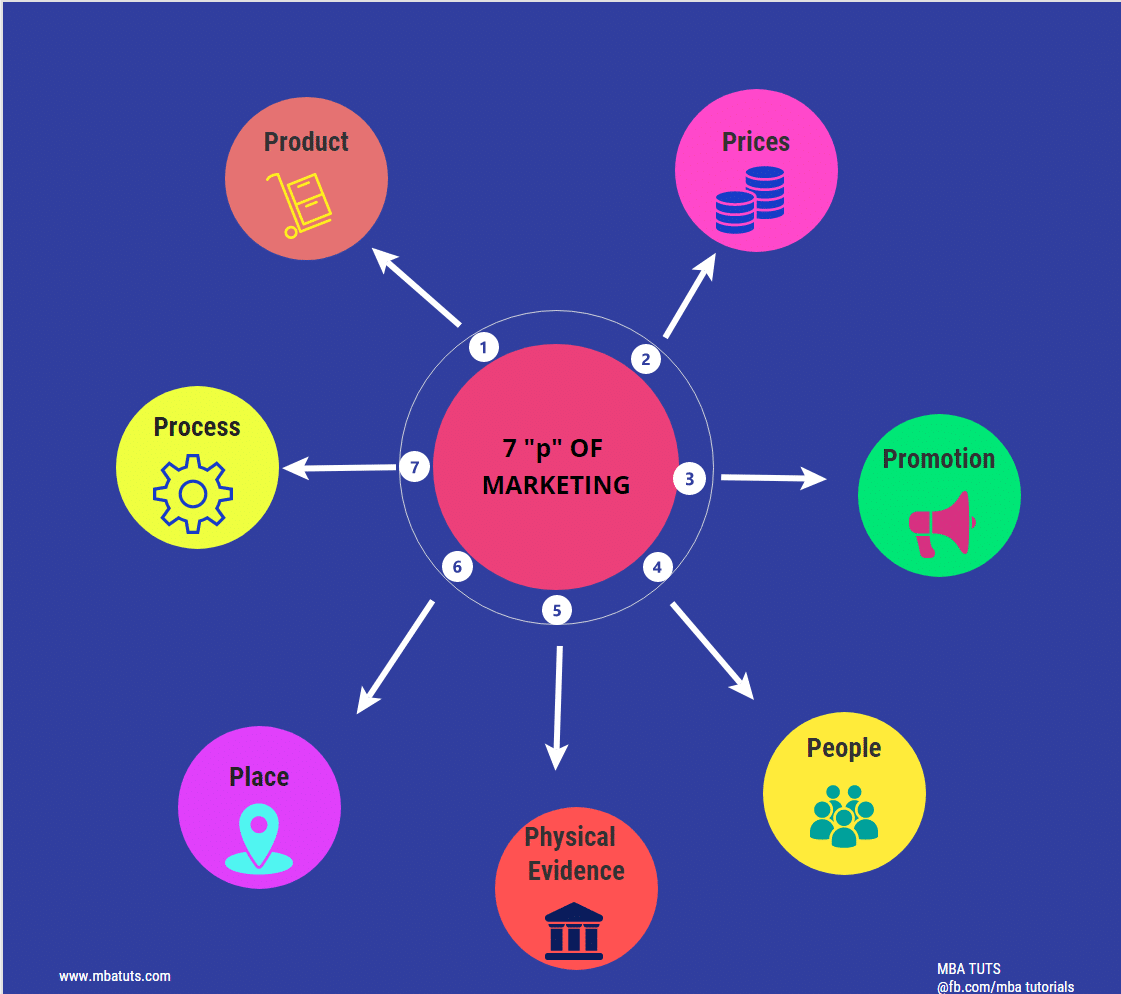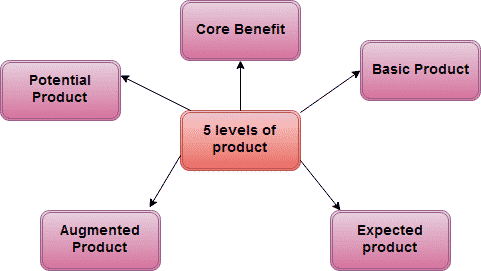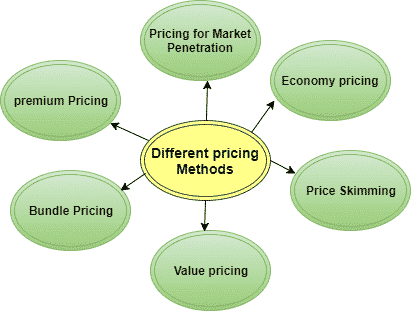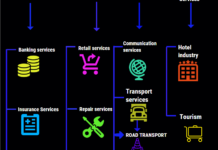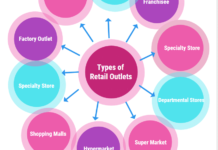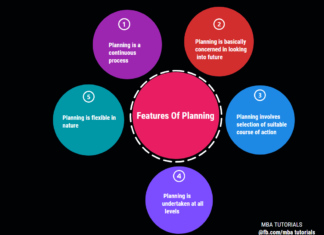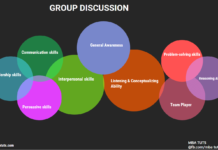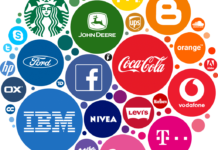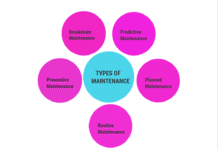7 Ps of Service Marketing
As services are intangible in nature, perishable it is very difficult to market a service. The success of services depends on the combination of the various market mix. He also ensures that customer perceives his offering as more attractive than the competitor’s offer.
In the case of services, people involved in providing services are most important so training plays an important role in quality service. Being intangible physical evidence of infrastructure, layout, ambiance, dress code for employees etc plays a crucial role.
7 PS Of Service Marketing
1) Product
A product can be defined as a mix of intangibles & tangibles offered by the marketers at a price customer buys a product by paying a certain amount. A product is anything that is offered in the market to satisfy the needs and wants of the customer though services are intangible it is very difficult to sell the services.
A product is divided into 5 levels are as follows
1) Core benefit:- It is the functional benefit of the service that the customer is buying
For E.g:- In the case of a bank ( deposit, withdrawal of money, loan. In the case of a bank, finance activity is the core benefit
In the case Of traveling core benefit to the customer is transportation
2) Basic Product:- It is a product that gives basic attribute to service in case of banking bank may be nationalized, cooperative, private, international
3) Expected Product is a set of benefit which is normally expected of us
For E.g In the case of private bank quick money transfer, easy loan documentation adequate information regarding various services of the bank immediate action on a problem is expected by the customer.
4) Augmented product. Here service provider offers benefits behind the expectation
For E.g. ATM 24*7, Internet banking, and debit card stock booking. At this level service providers try to build their brand and position themselves by offering a set of an attribute different than their competitors.
5) Potential product: This level consists of all potential features benefits & utilities for the future. This level attracts new users potential level is developed for services to sustain in the competition each service product line is managed by an executive to fulfill the needs of a different segment
For e.g Indian post gives the following product line
a. Normal routine post service
b. Speed Post
c. Satellite Post
d.Electronic demand draft
e Electronic mail
f Express Parcel
2. Prices
Price is only one p which generates revenue other 6 ps are cost carrying. Pricing is one of the crucial p of marketing because it is directly linked to revenue before pricing & service you have to consider a variety of features
For e.g Pricing for cash purchases, credit, installment,
Factors affecting pricing
Internal as well as external factors affect the pricing policy of the firm
A.Internal factor
- Objectives of service provided
- Objectives of marketing
- Characteristics of services
- The elasticity of demand & of services
- Stages of the service lifecycle
- Composition of product line of service provided
B External Factor
- Market characteristics for e.g. size of market type of composition, present demand & services
- Buyer’s behavior in respect of services
- Bargaining power of customer
- Competitor pricing policy
- Legal aspect
- Government regulation on pricing-service
Objectives Of Pricing
- Profit maximization in short-term
- Profit optimization in long-term
- Minimum return on investment
- Achieving certain sales volume
- Penetration in the market
- Entering into a new market
- To sustain in a market with the present competition.
Different Pricing Method
1. Premium Pricing
With, premium pricing businesses set costs higher than their competitors. Premium pricing is often most effective in the early days of a product’s lifecycle and is ideal for small businesses that sell unique goods. Because customers need to perceive products as being worth the higher price tag, a business must work hard to create a value perception.
2. Pricing for Market Penetration
Its aim is to attract buyers by offering lower prices on goods and services. While many new companies use this technique to draw attention away from their competition, penetration pricing does tend to result in an initial loss of income for the business.
Over time, however, the increase in awareness can drive profits and help small businesses to stand out from the crowd. In the long run, after sufficiently penetrating a market, companies often wind up raising their prices to better reflect the state of their position within the market.
3. Economy Pricing
Used by a wide range of businesses including generic food suppliers and discount retailers, economy pricing aims to attract the most price-conscious of consumers. With this strategy, businesses minimize the costs associated with marketing and production in order to keep product prices down. As a result, customers.
4. Price Skimming
Designed to help businesses maximize sales of new products and services, involves setting rates high during the introductory phase. The company then lowers prices gradually as competitor goods appear on the market.
One of the benefits of price skimming is that it allows businesses to maximize profits on early adopters before dropping prices to attract more price-sensitive consumers. Not only does price skimming help a small business recoup its development costs, but it also creates an illusion of quality and exclusivity when your item is first introduced to the marketplace.
5. Value Pricing
In value pricing value of the service is considered for the pricing strategy. Here this pricing captures the value of the product persuasively by the customer
6. Bundle Pricing
With bundle pricing, small businesses sell multiple products for a lower rate than consumers would face if they purchased each item individually. Not only is bundling goods an effective way of moving unsold items that are taking up space in your facility, but it can also increase the value perception in the eyes of your customers since you’re essentially giving them something for free.
3. Promotion
This promotion mix stimulates the buyer to purchase the service. The key to making promotion successful service providers always consider the customer’s view or they try how the service buying is more beneficial to the customer
Being services are intangible it is very difficult to frame. There are various promotional objectives
1 Advertising
2 Personal Selling
3 Publicity/ Public relation
4 Sales Promotion
This promotion mix stimulates the buyer to purchase the service. The key to making promotion successful service providers always consider the customer’s views or they try how the service buying is more beneficial to the customer.
Being services are intangible it is very difficult to frame there are various promotional objectives
i) To build awareness & interest in the service provided
ii) To differ a service offer & service provider from the competitors
iii) Communicate & highlight the various benefit of the services
iv)To build & maintain the overall image & reputation of a service provider
v)To perceive, and influence a customer through the service
Ultimately the purpose is to sell service products by informing, persuading & reminding
Types of Promotion Mix are as Follows
I) Advertising
Advertisement can be defined as the “paid form of non-personal presentation and promotion of the idea, goods or services by an identified sponsor”.
It is an impersonal presentation where a standard or common message regarding the merits, price, and availability of a product or service is given by the producer or marketer. The advertisement builds a pull effect as advertising tries to pull the product by directly appealing to the customer to buy it.
From the above definition, we can find that the three distinct features of advertising are as follows
1. Paid Form
The sponsor has to pay for advertising he has to bear the cost to communicate with customers
2. Impersonality
There is no face-to-face contact with customers and advertisers. It creates a monologue and not a dialogue.
3. Identified Sponsor
The advertisement is given by an identified company or firm or individual.
Features of Advertising and Advantages/Merits of Advertisement:
(i) Reach
Advertising can reach a large market. Through various media of advertising, there is a benefit of mass reach, for example, any message given on All India Radio or TV can reach different corners of the country wherever TV and Radio network is available.
(ii) Choice
There is a wide variety of media available for advertising video, audio, visual audio, print media, etc. Under each category large variety is available for example, in print media we can select from magazines, newspapers, banners, etc. This variety of choices helps the marketer to select the media, keeping in mind the target customer.
(iii) Legitimacy
In the advertisement, the messages regarding the product or service are given publicly to customers so there is always proof for it and customers believe that publicly the company will not give false information about the product. The customer feels comfortable buying a product that is widely advertised.
(iv) Expressiveness
Advertising provides enough opportunities for marketers to dramatize the message with the help of drawings, colors, pictures, music, dance, etc. They can easily express the use of products through various techniques and can add multimedia effects also.
(v) Economy
It is always felt that advertising increases the cost of a product or service but advertising is considered economical as compared to other promotional techniques because it reaches the masses and if we calculate a cost per customer it is very low or nominal.
(vi) Enhancing Customer Satisfaction and Confidence:
The customer feels more assured about the quality and feels more comfortable if sponsors claim these benefits in advertising.
Disadvantages of Advertising:
(i) It is an Impersonal Communication/Less Forceful
In advertising, there is no direct communication between the customer and the marketer. The marketer assumes that the message is communicated but the audience or customers do not pay any attention to impersonal messages conveyed through advertising. The response of customers cannot be known in advertising.
(ii) Advertising is less effective
In advertising, there is only one-way communication i. e-communication from the seller only, but two-way communication is always more effective as in two-way communication the customer gets a chance to clarify his or her queries. Sometimes customers have many doubts regarding the use of the product, these doubts can be clarified only when there is two-way communication.
(iii) Difficulty in Media Choice
In advertising various media are available. Each media has its own advantages and disadvantages. So the effectiveness of advertisement depends to a great extent on the right choice of media. When the choice of media is faulty or wrong no matter how good the advertisement is it will not reach the target customer.
(iv) Inflexibility
It is very difficult to change advertisements as companies use standardized messages which cannot be changed according to the need of customers.
(v) Lack of Feedback
The evaluation of advertisements is very difficult as there is no immediate and accurate feedback given by the customers.
ii) Sales Promotion
Sales promotion refers to the short-term use of incentives or other promotional activities that stimulate the customer to buy the product. These techniques are very useful because of the following.
(a) The short and immediate effect on the sale.
(b) Stock clearance is possible with sales promotion.
(c) Sales promotion techniques induce customers as well as distribution channels.
(d) Sales promotion techniques help to win over the competitor.
Sales Promotion Techniques for Customers:
Some of the sales promotion activities commonly used by the marketer to increase the sale are:
(i) Rebate
It refers to selling a product at a special price that is less than the original price for a limited period of time. This offer is given to clear off the stock or excessive inventory for example; coke announced 2-liter bottles at Rs 35 only.
(ii) Discounts
This refers to the reduction of a certain percentage of the price from the list price for a limited period of time. The discounts induce the customers to buy and to buy more. Generally, at the end of the season, big companies offer their products at a discounted price to clear off the stock e.g., season’s sale at Snow-White Jain Sons, Paul Garments, Bhuvan Garments, etc.
(iii) Refunds
This refers to a refund or part of the price paid by the customer on presenting the proof of purchase, for example, Rs 2 off on the presentation of an empty pack of Ruffle Lays.
(iv) Premiums or Gifts/or Product Combination
These are the most popular and commonly used promotion tools. It refers to giving a free gift for the purchase of the product. Generally, the free gift is related to the product but it is not necessary for example, Mug free with Bourn Vita, Shaker free with Coffee, Toothbrush free with Toothpaste, etc.
(v) Quantity Deals
It refers to the offer of extra quantity in a special package at less price or on extra purchase some quantity free for example, buy three get one free e.g., this scheme of buy three get one free scheme is available on soaps.
(vi) Samples:
It refers to the distribution of free samples of the product to the customers. These are distributed when the seller wants the customer must try the product. Generally when a new product is launched for example, when Hindustan Level launched Surf Excel it distributed the samples as it wanted the customers to try it.
(vii) Contests:
It refers to the participation of consumers in competitive events organized by the firm and winners are given some reward, for example, Camlin Company organizes a painting competition, Bourn vita quiz contest, and some companies organize a contest of writing slogans, and the best slogan is awarded the prize.
(viii) Instant Draws and Assigned Gifts:
It includes offers like ‘scratch a card’ and wins instantly a refrigerator, car, T-shirt, computer, etc.
iii. Personal Selling.
Personal selling means selling personally. This involves face-to-face interaction between seller and buyer for the purpose of sale.
Personal selling does not mean getting the prospects to desire what a seller wants but the concept of personal selling is also based on customer satisfaction.
Features of Personal Selling
(i) Personal Interaction
In personal selling, the buyers and sellers have face-to-face interaction. This closeness allows both parties to observe each other’s actions closely.
(ii) Two-Way Communication:
In personal selling, the sellers give information about the product, and at the same time, the buyer gets a chance to clarify his doubts. It is suitable for the sale of complex products where a buyer wants to interact with the manufacturer.
(iii) Better Response
When a seller is personally explaining the utilities of the product to the customers then customers do pay some attention and listen to the information.
(iv) Relationship
When the seller and buyer come together this may improve the relationship between the customer and seller. Salespersons normally make friendly relations with the customers.
(v) Better Convincing
Personal selling is the most effective form of promotion because with this the salesperson can convince the buyer by demonstrating the use of the product and making changes in the product according to the need of a customer.
iv. Public Relations.
Apart from the four major elements of the marketing mix, another important tool of marketing is maintaining Public Relations. In simple words, public relation means maintaining public relations with the public. By maintaining public relations, companies create goodwill.
Public relations evaluate public attitudes; identify the policies and procedures of an organization with the public interest to earn public understanding and acceptance.
The public does not mean only customers, but it includes shareholders, suppliers, intermediaries, customers, etc. The firm’s success and achievement depend upon the support of these parties, for example, the firm needs the active support of middlemen to survive in the market, and it must have good relations with existing shareholders who provide capital. The consumer group is the most important part of the public as a success of a business depends upon the support and demand for customers only.
The Significance of public relations:
Public relations are significant in the following ways:
- Help to convey the policies and programs of the organization
- Help to collect information about public opinion about the organization, management activities, etc.
- overcome the complaints and dislikes of the public.
- molding people’s attitudes in favor of the organization.
- To maintain goodwill and understanding between an organization and the public.
- For maintaining the image of the organization.
Ways/Methods and Tools of Public Relations
The companies can use the following tools to improve their relations with the public
a) News
Sometimes companies get involved in such kinds of activities or make such policies so that they get some positive coverage in news. For example, a company’s name may be covered in news for the reservation of jobs for women or for introducing new technology, etc.
b) Speeches
The speeches given by the leaders of corporate sectors influence various members of the public especially banks, shareholders, etc. The public relations department creates an occasion when the speeches are delivered by the leader of a company.
c) Events
Events refer to organizing press conferences, multimedia presentations, matches, stage shows, etc.
d) Written Materials
Sometimes written materials such as Balance Sheets, Annual Reports, Special documents, Brochures, etc. are circulated to various parties to improve and maintain the public image of the company.
e)Public Service Activities:
Big business houses often associate themselves with various social service projects such as women’s welfare, charity shows, up-keeping of parks, planting trees on the roadside, training schools, running schools, colleges, hospitals, etc.
4. People
People are one of the important aspects of service. As the people are involved in the delivery of a service provider.
For eg Behavior of clerk, accountant, cashier plays a very important role in the banking transaction. Quality of service delivery wholly depends on the personnel involved in the service process
This personal reflect organizational realities, brand name quality of service as they have the direct interaction win the customer
By observing staff behavior knowledge above service & a variety of skills like communication, Persuasion, and customization, customers develop beliefs & attitudes towards the service provider Organisational personnel involved in service product performance & delivery
In the service industry, there are two types of personnel involved
- Contact Personal
- Support Personal
- Contact Personal
This personnel have direct contact with the customer to make the service more qualitative & to increase customer satisfaction they require high personal & professional skill
For E.G Air hostess front office staff in a bank, and vectors in hotels this contact with an employee has a great influence on the customer because contact with the employees represents the organization & directly influences the customer satisfaction
The degree of customer contact varies as per the nature of the service
1. High Contact Personnel
Eg- Educational Institutes, Hospital Consultancy. All these required physical presence & interaction with a customer is required
2. Low Contact Personnel
In low contact, customer-employee has very little interaction with the customer
For Eg Retailing post office, Courier services. In low personal contact instead of interpersonal skills technical & analytical attributes are more important
Support Personnel
Employees will contribute service but do not come in direct contact with the customer this is called non-contact employees
For Eg Shift in hotels, maintenance worker, cockpit crew in airplane
5 ) Physical Evidence
Being services are intangible in nature they are highlights & in nature, and they are highlighted & influence the customer by physical evidence which is tangible
For Eg Printed brochures of educational institutes, Infrastructure in bank
These tangibles help the service provider to sell the intangible. Physical evidence is also called as atmosphere or ambiance while availing of any service customers buying behavior & attitude can be affected by physical aspects of various services
E.g Bank Retail, Hospital, Education, Insurance, and Telecommunication by its building layout, lighting system cleanliness location & the dress code of the employees.
In the case of restaurants following features add to the physical evidence
-Location
Parking space
Building structure
The layout of the restaurant
The dress code of staff, menu card, building, etc.
There are two types of physical evidence
a) Essential Evidence.
b)peripheral Evidence.
a. Essential Evidence
Evidence constitutes an important part of the service facility not tangible but the customer experience the customer
For E.g Hotel building furniture in bank
b. peripheral Evidence
These are not visible but these are usually part of the purchase of the service
E.g Admission cards, billing statements, brochures, medical reports, checkbooks
6. Place
The product must be available at the right place, at the right time, and in the right quantity. The place where customers buy a product, and the means of distributing your product to that place, must be appropriate and convenient for the customer. Customer surveys show that delivery performance is one of the most important criteria when choosing a supplier. The place also means ways of displaying your product to customer groups. This could be in a shop window, but it could also be online. E-commerce operations that sell exclusively on the internet must place even more emphasis on the company website and other online activities.
There are 3 methods in the delivery of services
i) Customer goes to the service provider
E.g. Retail, hotel, education, Hospital
ii) Service organization comes to the customer
E.g. Private courier special health care services
iii) Customer & service provider transact at length or certain distance
Eg credit card, Debit card, ATM machine
7. Process
Many customers no longer simply buy a product or service they invest in an entire experience that starts from the moment they discover your company and lasts through to purchase and beyond. The value of a good is the first impression. Ensure that your systems are designed for the customer’s benefit, not only for the company’s convenience. Do customers have to wait? Are customers kept informed? Is your website fast enough and available on the right devices? Are your people helpful? Is your service efficiently carried out? Do your staff interact in a manner appropriate to your pricing
For more articles related to service, marketing click here


